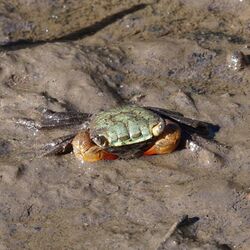Biology:Parasesarma erythrodactyla
| Parasesarma erythrodactyla | |
|---|---|

| |
| Scientific classification | |
| Domain: | Eukaryota |
| Kingdom: | Animalia |
| Phylum: | Arthropoda |
| Class: | Malacostraca |
| Order: | Decapoda |
| Suborder: | Pleocyemata |
| Infraorder: | Brachyura |
| Family: | Sesarmidae |
| Genus: | Parasesarma |
| Species: | P. erythrodactyla
|
| Binomial name | |
| Parasesarma erythrodactyla (Hess, 1865)
| |
Parasesarma erythrodactyla, also known as the red-handed shore crab, is a burrowing crab inhabiting mangrove forests in Australia and Southeast Asia. It is immediately identifiable by its bright red chelipeds (claws) and green/brown carapace.
Distribution of P. erythrodactyla occurs mainly in tropical and subtropical regions along eastern Australia, Indonesia, Taiwan, Korea and India . They may also occur along southern Australia (to be verified).
P. erythrodactyla relies mangrove leaf detritus for about 65%-80% of its nutrition,[1] and on benthic microalgae such as diatoms for between 20% and 35% of its nutrition.[2]
Sesarmid crabs are generally considered to be a monophyletic taxon (that is, all genetically deriving from a common ancestor) of Grapsoidea, but recent reclassifications of the genera Sesarma and Parasesarma (both considered polyphyletic) have resulted in a reshuffling of the species.[3]
A type specimen exists in the Melbourne Museum Discovery Centre (object drawer 15).[4]
References
- ↑ R. M. Connolly; J. M. Oakes (2007). "Carbon pathways in estuarine foodwebs: stable isotope evidence further enriched". AMSA Conference Abstract Oral Proceedings: 26.
- ↑ J. M. Oakes, R. M. Connolly & A. T. Revill. "Enriched carbon isotope labelling to trace the contribution of benthic microalgae to the nutrition of consumers in mangrove forests". AMSA Conference Abstract Oral Proceedings: 26.
- ↑ C. D. Schubart; D. Cannicci; M. Vannini; S. Fratini (2006). "Molecular phylogeny of grapsoid crabs (Decapoda, Brachyura) and allies based on two mitochondrial genes and a proposal for refraining from current superfamily classification". Journal of Zoological Systematics and Evolutionary Research 44 (3): 193–199. doi:10.1111/j.1439-0469.2006.00354.x.
- ↑ Melbourne Museum. "Parasesarma erythrodactyla". Discovery Centre. https://museumsvictoria.com.au/MelbourneMuseum/DiscoveryCentre/Results/?subject=marine&searchtype=obj&topic=Marine+Life&rs=51&pgn=25/.
Wikidata ☰ Q7135904 entry
 |

